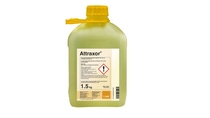BASF Professional & Specialty Solutions
PGR helps control Poa annua
Dudsbury Golf Club Head Greenkeeper, Warren Moss, has adopted the use of a new plant growth regulator (PGR) to suppress Poa annua and increase the quantity of bent grass on the greens.
Attraxor® is a new BASF product and Warren has been working with David Chammings, from distributor Agrovista Amenity, to help manage the greens at Dudsbury. “The Poa had crept in and we estimated it at 70 percent in 2019. Since starting with Attraxor in May I have been able to suppress the Poa and through a reseeding programme the greens are now 70 percent bent grass, which is a great turnaround in such a short time period,” he explains.
Dudsbury Golf Club Hotel and Spa was formed in 1995 and built on former farmland. “It’s a wonderful spot, but the land has its drawbacks. Areas of the course adjoin the River Stour, but luckily the greens were built high enough to not flood. However, the land is extremely fertile so keeping on top of the Poa has been a challenge,” says Warren.
Being less than ten miles from the south coast the course also has to cope with very dry conditions and high temperatures. “This year has been a real challenge. First, we had heavy rain and then the driest spring I can remember. We have some irrigation, but I am limited to 13,500 cubic metres per year, so it has been difficult to give the course enough water. I have used wetting agents to help but with only seven days of rain between March and the beginning of September it has been tricky,” he says.
The course is largely south facing and the extremely sunny and warm weather of 2019 and 2020 has made maintenance difficult. The soil, being former farmland, drains quickly which helped in the heavy rain early in the year, but only added to Warren’s workload in the hot and dry spring and summer. “The greens are US spec and so are free draining and we have been overseeding with a traditional bent grass mix to try and push back the Poa,” he says. “The Poa had really crept in and left us with very little bent grass which was causing uneven surfaces and affecting playability,” he adds.
To overcome the problems with Poa annua, Warren was recommended Attraxor by David Chammings at Agrovista Amenity. “This product is unique because it reduces clippings like other PGRs, but it also suppresses the seed heads of Poa annua,” explains David. “It fitted well with what Warren needed to bring back the bent grass in the greens at Dudsbury and we are both really pleased with the results,” he adds.
Warren has used Attraxor at a low dosage of 0.375 kg/ha. The recommended application for Poa annua management is from 0.5 kg/ha to 0.65 kg/ha. However, Warren wanted to be cautious because of the high percentage of Poa annua on the greens. “Using Attraxor at 0.375 kg/ha was the right decision for this course and I have supressed the seed head production without yellowing the greens,” he says. Attraxor contains the active prohexadione-calcium which regulates longitudinal turf growth to reduce clippings and helps to reduce the seed head production of Poa annua.
By suppressing the Poa annua, Warren has been able to reduce the amount of fertiliser and water needed on the course. “We were spending too much on fertiliser and using too much water to keep the Poa happy. However, this is water that we need elsewhere and so by using Attraxor we have been able to improve the balance throughout the course,” he says.
Five years ago, the course was being reseeded with traditional bent grass to try and push back the Poa annua. However, the result was uneven growth in the spring and the Poa annua seed heads were still causing the greens to be bumpy. “Two years ago, I swapped to a Riptide bent grass and it took really well, but we had variations in speed caused by the Poa which is why I was so interested in trying Attraxor,” says Warren.
Warren started the Attraxor treatment on 11th May. “We used 0.375 kg/ha and saw a change in the Poa the next day. We continued to apply in 21-day intervals at the same dosage and I have seen no seed head production this year,” he explains. Warren chose overcast mornings to apply the product using Stressbuster and 2.5 kg/ha of N to prevent any yellowing. “Seed heads were suppressed and unlike other PGRs it also regulates the growth of the other grass varieties more consistently. I was especially impressed that it lasted the full 21 days too,” he adds.
Warren uses some granulars on the greens and an organic approach to disease management with relatively low inputs of N. “This year we are expecting to use no more than 55 kilos of N for the greens. We have increased the percentage of bent grass to 70 percent in the last two years and so essentially reversed the 70/30 split from Poa annua to bent grass,” he says. “This year was the year to get aggressive with the Poa because there has been far less playing time for the members due to lockdown restrictions and I’m really pleased we took the plunge,” he adds.
The course was reseeded in August 2020 and Warren is hoping that this will increase the density of bent grass to more than 80 percent by May 2021, when it has had chance to establish. “I carried out the final application of Attraxor on 12th August before our maintenance week and I plan to use it again from the end of April 2021 to tie in with competitions and my maintenance week. It has really helped suppress the Poa and has given us the opportunity to return the greens to largely bent grass in such a short time period that I want to keep it and make it part of the annual treatment programme,” he concludes.
Using Attraxor® has helped to tackle the large quantities of Poa annua and make the greens at Dudsbury Golf Course more than 70% bent grass.
Related News
Information: Use biocide products carefully. Always read the label and product information before use.



